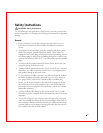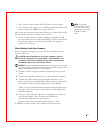
2
www.dell.com | support.dell.com
• To help protect your computer from sudden, transient increases and
decreases in electrical power, use a surge suppressor, line conditioner,
or uninterruptible power supply (UPS).
• Ensure that nothing rests on your computer’s cables and that the
cables are not located where they can be stepped on or tripped over.
• Do not push any objects into the openings of your computer. Doing so
can cause fire or electric shock by shorting out interior components.
• Keep your computer away from radiators and heat sources. Also, do not
block cooling vents. Avoid placing loose papers underneath your
computer; do not place your computer in a closed-in wall unit or on a
bed, sofa, or rug.
When Using Your Computer
As you use your computer, observe the following safe-handling guidelines.
CAUTION: Do not operate your computer with any cover(s)
(including computer covers, bezels, filler brackets, front-panel
inserts, and so on) removed.
Your computer is equipped with one of the following:
• A fixed-voltage power supply — Computers with a fixed-voltage power
supply do not have a voltage selection switch on the back panel and
operate at only one voltage (see the regulatory label on the outside of
the computer for its operating voltage).
• An auto-sensing voltage circuit — Computers with an auto-sensing
voltage circuit do not have a voltage selection switch on the back panel
and automatically detect the correct operating voltage.
• A manual voltage selection switch — Computers with a voltage
selection switch on the back panel must be manually set to operate at
the correct operating voltage.
To help avoid damaging a computer with a manual voltage selection switch,
ensure that the voltage selection switch is set to match the AC power
available at your location:
• 115 V/60 Hz in most of North and South America and some Far
Eastern countries such as South Korea and Taiwan


















